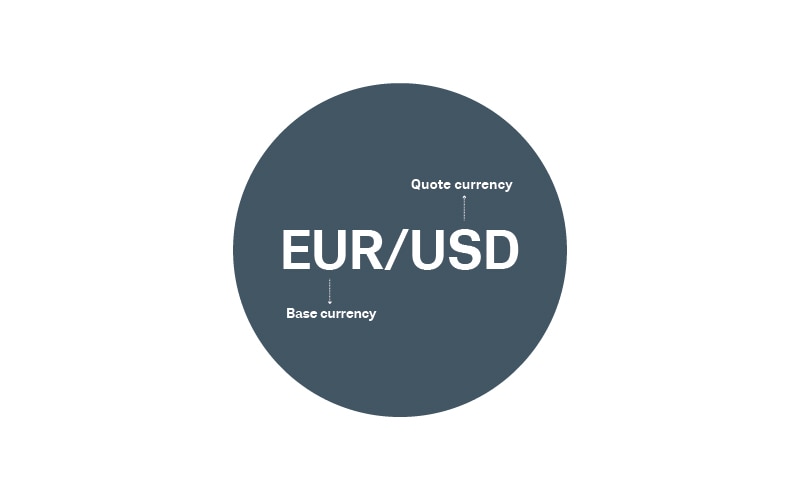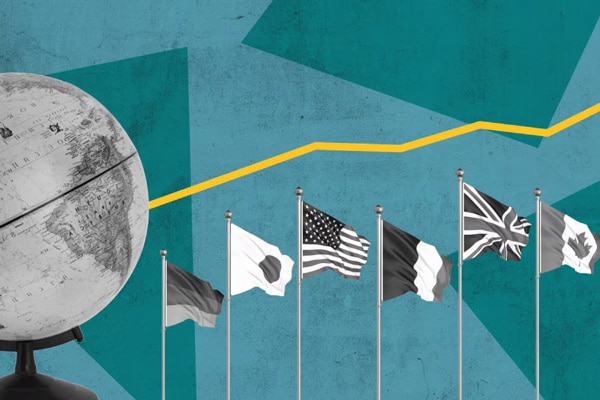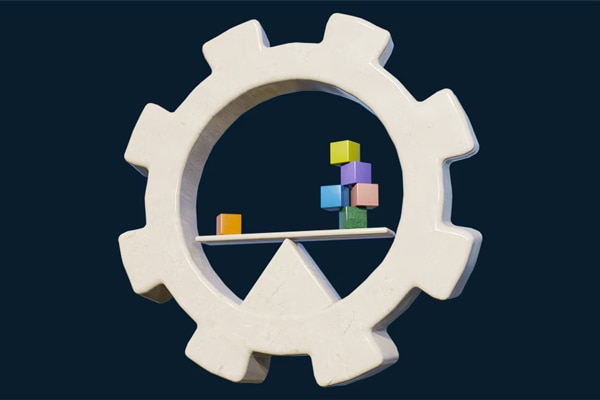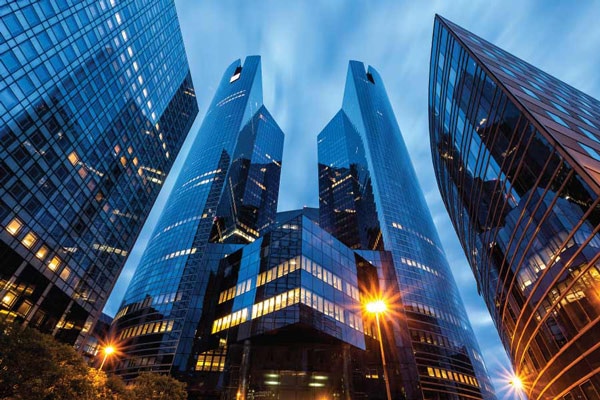What is forex trading?
In simple terms, forex trading is the simultaneous buying and selling of currencies from two different countries—hoping for a profit as their values go up and down. Let's dive into how forex works.
Forex trading is provided by Charles Schwab Futures and Forex LLC.

The basics of forex.
The world's largest financial market.
Forex is a global, decentralized market where one nation's currency can be exchanged for another. Unlike stocks, where a company's shares are exchanged by investors in a centralized physical or electronic marketplace, forex trading occurs in a decentralized electronic marketplace made up from a network of buyers and sellers located around the world. Trillions of dollars are exchanged in the forex market each trading day.
The best things come in pairs.
Forex is traded in pairs—meaning you're buying one while simultaneously selling another. The first currency listed is called the "base currency" and the second is the "quote currency." When trading, you're speculating whether a currency will rise or fall against the other. Pairs are categorized in three ways:
- Major pairs: The most popular traded currencies from big stable economies—always including the U.S. dollar.
- Minor pairs: Major currencies, not including the U.S. dollar, paired with smaller or less common economies.
- Exotic pairs: Major currencies (which could include the USD) paired with a smaller, emerging market—usually countries with developing economies.
Currency pairs available at Schwab.
| Currency | Pairs |
|---|---|
| AUD (Australian Dollar) | AUD/CAD, AUD/CHF, AUD/JPY, AUD/NOK, AUD/NZD, AUD/PLN, AUD/SGD, AUD/USD |
| CAD (Canadian Dollar) | CAD/CHF, CAD/JPY, CAD/NOK, CAD/PLN |
| CHF (Swiss Franc) | CHF/HUF, CHF/JPY, CHF/NOK, CHF/PLN |
| EUR (Euro) | EUR/AUD, EUR/CAD, EUR/CHF, EUR/CZK, EUR/DKK, EUR/GBP, EUR/HKD, EUR/HUF, EUR/JPY, EUR/MXN, EUR/NOK, EUR/NZD, EUR/PLN, EUR/SEK, EUR/SGD, EUR/USD, EUR/ZAR |
| GBP (Pound Sterling) | GBP/AUD, GBP/CAD, GBP/CHF, GBP/DKK, GBP/HKD, GBP/JPY, GBP/NOK, GBP/NZD, GBP/PLN, GBP/SEK, GBP/SGD, GBP/USD, GBP/ZAR |
| HKD (Hong Kong Dollar) | HKD/JPY |
| NOK (Norwegian Kroner) | NOK/SEK, NOK/JPY |
| NZD (New Zealand Dollar) | NZD/CAD, NZD/CHF, NZD/JPY, NZD/USD |
| SGD (Singapore Dollar) | SGD/HKD, SGD/JPY |
| USD (U.S. Dollar) | USD/CAD, USD/CHF, USD/CZK, USD/DKK, USD/HKD, USD/HUF, USD/ILS, USD/JPY, USD/MXN, USD/NOK, USD/PLN, USD/SEK, USD/SGD, USD/ZAR |
| ZAR (South African Rand) | ZAR/JPY |
How to trade forex.
The first step to trading forex is understanding the key concepts around it.
Identify your opportunities and risks.
Do your research. Use a combination of technical and fundamental analysis to understand chart patterns and dive into economic factors that could influence currency prices, to help craft a comprehensive plan.
See the market potential.
Bullish. Bearish. It doesn't really matter. Since all forex trading is done in pairs, when one currency is weakening, the other is strengthening, allowing you to take advantage of both rising and falling markets.
Nail down the lingo.
Sometimes trading can seem like it has its own language. But, when you're familiar with the terminology, it makes things easier. Here are a few forex terms you should get to know.
- Pip: Short for "percentage interest point," it's the smallest change in price for a currency pair (1/100 of 1%, or 0.0001).
- Spread: The difference between the buying price (ask) and the selling price (bid) of a currency pair.
- Lot: The size of the trade or the amount of currency you're buying or selling.
Let's see what a forex trade could look like:
Do you believe that the euro will increase in value relative to the U.S. dollar and want to speculate on that potential outcome? You'd do that using the EUR/USD pair. The euro (EUR) would be the base currency, and the U.S. dollar (USD) would be the quote currency.
Here's how it might play out:*
- Current price: EUR/USD pair is trading at 1.105. 1 EUR is equal to $1.105 USD.
- Trade: You buy 10,000 EUR against the USD at a rate of EUR/USD = 1.105.
- Initial investment: To buy 10,000 EUR, you'd pay $11,050.
- Price movement: As you predicted, the EUR/USD rate increases to 1.125 (a 200 pip change).
- Closing the trade: You sell your 10,000 EUR at the new rate of 1.125.
- Profit: You'd receive $11,250 for selling your EUR—resulting in a $200 profit.
As you can see, this example involves buying and selling the full value of a currency. But most forex trades use leverage to establish a position with a relatively small amount of money (typically 2% to 5% of the currency's notional value). If this trade was made using margin, the same $200 profit outcome would have required only a $221 deposit (based on 2% margin required). Keep in mind that while leverage can lead to greater profits, it can lead to greater losses—beyond your initial investment.
*For illustrative purposes only.

Learn more about how to start trading forex at Schwab.
Why trade forex?
Capital efficiency
Forex trading involves using margin and leverage—which means you can establish a position with a relatively small amount of money. This could lead to significant profits, but also increased risk of larger losses, even with small price movements. You can read more about forex margin here.
Liquidity
Forex is generally a very active market. With lots of trades happening, it's designed to help keep costs low and spreads tight and to let you enter and exit positions smoothly.
Around-the-clock trading opportunities
Forex never sleeps. Respond to market conditions and economic events with trading hours 23 hours per day, 5 days per week.
Commission-free trading
There are no commission fees when you trade forex with Schwab. Trade costs are reflected in the bid-ask spread.
Forex FAQs
Forex markets are open 23 hours per day, 5 days per week, allowing you to respond to market conditions and economic events as they happen.† The forex trading hours at Schwab are 6:00 p.m. ET on Sunday through 5:00 p.m. ET on Friday.
Forex trading is commission-free and trade costs are reflected in the bid-ask spread.
Forex trading involves using margin to establish a position in a larger investment with a relatively small amount of money. This means it's highly leveraged, which creates the potential for larger returns but can also magnify losses, even with small price movements. Read more about forex margin.
Ready to trade?
Not yet a Schwab client?
Open a brokerage account online, then go to the Getting Started page for next steps.
Already a client?
Use your eligible brokerage account to open a forex trading account.






